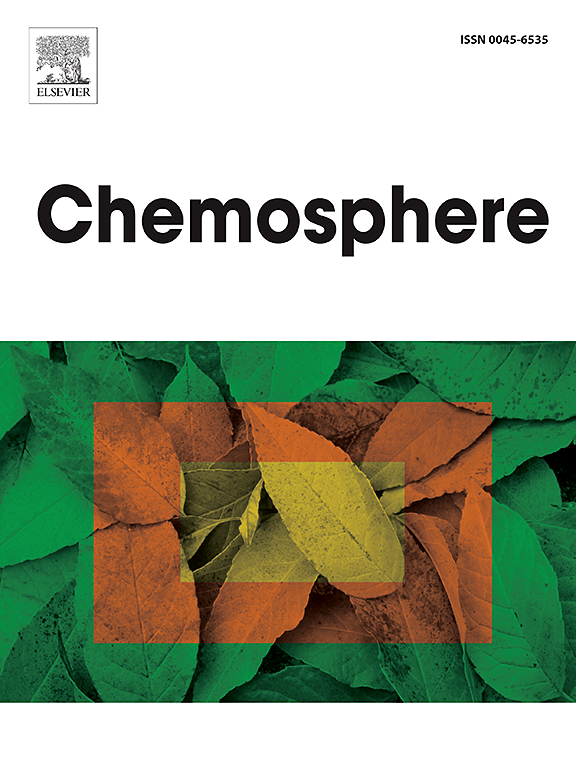热带河口红树林蟹的锌稳定同位素作为人为污染的示踪剂
IF 8.1
2区 环境科学与生态学
Q1 ENVIRONMENTAL SCIENCES
引用次数: 0
摘要
本研究提出了一种利用锌稳定同位素组成(δ66Zn)追踪红树林蟹类人为锌(Zn)生物积累的新方法。我们分析了巴西红树林螃蟹组织中的δ66Zn和元素组成,这些螃蟹组织位于历史上受到电镀废物影响的沿海泻湖内。在老电镀厂附近的红树林地区,螃蟹肌肉和肝胰腺的锌浓度最高,可能反映了这些沉积物中锌的高生物利用度。相比之下,来自其他红树林地点的螃蟹在锌浓度上的变化很小,尽管沉积物锌水平存在显著差异。这说明蟹类体内锌的浓度有一定的调节范围,与外部锌的生物利用度无关。污染地点蟹类组织中δ66Zn含量较重,与工业Zn污染沉积物中残留的δ66Zn含量一致。然而,δ66Zn与生物积累Zn或沉积物Zn水平没有直接相关性,这使得区分不同污染程度的站点具有挑战性。与沉积Zn相比,螃蟹组织中的δ66Zn同位素向较轻的方向移动表明了饮食、内部生物分异、特定生物积累途径或其他Zn来源的影响。螃蟹体内的生物分离可能导致肌肉组织的同位素比肝胰腺轻,特别是在中度污染地区。本研究首次对红树蟹体内δ66Zn进行了系统的研究,强调了进一步研究螃蟹组织中δ66Zn的变化及其与环境、生态和生理因素的关系的必要性。初步研究结果表明,δ66Zn的来源、生物积累途径和调节机制决定了螃蟹组织中δ66Zn的形成。本文章由计算机程序翻译,如有差异,请以英文原文为准。

Zinc stable isotopes in mangrove crabs as tracers of anthropogenic contamination in a tropical estuary
Our study presents a novel approach for tracing anthropogenic zinc (Zn) bioaccumulation in mangrove crabs using Zn stable isotope compositions (δ66Zn). We analyzed δ66Zn and elemental composition in crab tissues from Brazilian mangroves within a coastal lagoon historically impacted by electroplating waste. Crabs from the mangrove area near the old electroplating plant exhibited the highest Zn concentrations in both muscle and hepatopancreas, likely reflecting the high Zn bioavailability in these sediments. In contrast, crabs from other mangrove sites showed minimal variations in Zn concentrations, despite prominent differences in sediment Zn levels. This suggests that crabs regulate their internal Zn concentrations within a specific range, not correlating with external Zn bioavailability. The tissues of crabs from contaminated sites bore heavier δ66Zn, consistent with the δ66Zn left by industrial Zn pollution in sediments. However, δ66Zn did not correlate directly with either bioaccumulated Zn or sediment Zn levels, making it challenging to distinguish between stations with varying contamination degrees. Shifting δ66Zn in crab tissues toward lighter isotopes compared to sedimentary Zn indicates the influence of diet, internal biological fractionation, specific bioaccumulation pathways, or additional Zn sources. Biological fractionation within crabs likely caused muscle tissues to be isotopically lighter than the hepatopancreas, especially in moderately contaminated areas. This first systematic study of δ66Zn within mangrove crabs highlights the need for further research to fully understand isotopic variations in crab tissues and their relationship with environmental, ecological, and physiological factors. Initial findings suggest that sources, bioaccumulation routes, and regulatory mechanisms shape δ66Zn within crab tissues.
求助全文
通过发布文献求助,成功后即可免费获取论文全文。
去求助
来源期刊

Chemosphere
环境科学-环境科学
CiteScore
15.80
自引率
8.00%
发文量
4975
审稿时长
3.4 months
期刊介绍:
Chemosphere, being an international multidisciplinary journal, is dedicated to publishing original communications and review articles on chemicals in the environment. The scope covers a wide range of topics, including the identification, quantification, behavior, fate, toxicology, treatment, and remediation of chemicals in the bio-, hydro-, litho-, and atmosphere, ensuring the broad dissemination of research in this field.
 求助内容:
求助内容: 应助结果提醒方式:
应助结果提醒方式:


